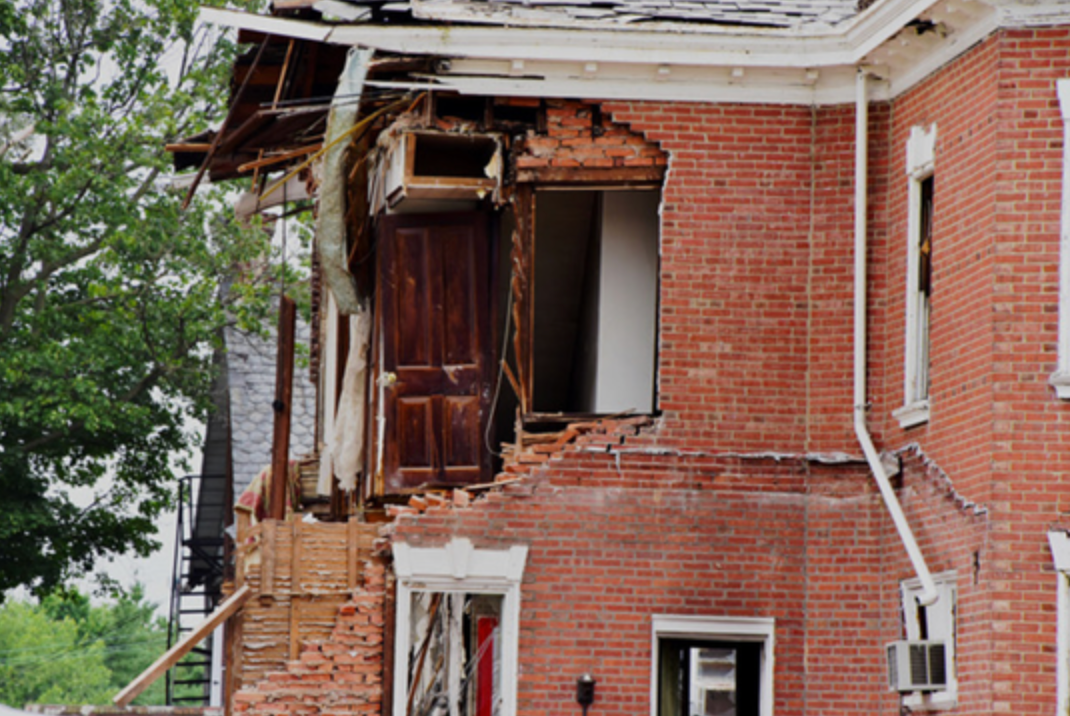
Editor’s note: I am happy to welcome another special guest (who also happens to be my friend and near-neighbour) to OHA+M.
Paul King is a retired real estate lawyer. A member of the St. Marys Heritage Committee and the St. Marys Committee of Adjustment and a director of the Friends of the St. Marys Museum, Paul is also Past President of Community Heritage Ontario and a Founding Member of the Stratford/Perth County Branch, Architectural Conservancy Ontario. He co-chaired the local planning committee for the 2016 Ontario Heritage Conference in Stratford/St. Marys and was a member of the local planning committee for the 2019 Ontario Heritage Conference in Goderich/Bluewater. Paul is the owner of a designated heritage home in St. Marys.
The recent amendments to the Ontario Heritage Act (OHA) and regulations became effective July 1, 2021. So, under the new provisions is there a clear distinction between demolition vs alteration? I would argue no. Even with this lack of clarity, does it matter? I would argue that sometimes it matters and sometimes not.
The fact that there were concerns with the distinction between the two is evidenced by the amendments themselves — and by further unproclaimed (possibly never to be proclaimed), amendments (“Unproclaimed Amendments”) that might have partly addressed the problems.
Just a warning: If you continue to read this article, be prepared to be confused.

There is no definition of “demolish” or “demolition” in the OHA (and this has always been the case). I find this rather odd given that the only restriction affecting a property owner of a non-designated property listed on a municipal register of heritage properties is that the owner must give notice of demolition to the municipal council. There is no such requirement for an alteration no matter how extensive that alteration may be. Even though there is no definition of demolition in the OHA (and whenever this word is used the reference is never clarified), it seems to be that demolition means the complete destruction of a building or structure and not partial destruction. So is partial destruction just an alteration?
There is a definition of “demolish” in subsection 1(1) the Ontario Building Code Act: “to do anything in the removal of a building or any material part thereof and 'demolition' has a corresponding meaning.” This definition, however, does not apply to the provisions of the OHA. The intent of the building code is to regulate standards for public health and safety, fire protection, structural sufficiency, energy conservation, water conservation, environmental integrity and barrier-free accessibility of buildings, but not to regulate heritage matters, which of course are regulated by the OHA. If a building is being demolished in whole or in part, a permit from the municipality's chief building official is required so that there is compliance with the building code. A heritage permit is a separate matter and is not required in every circumstance.
One of the Unproclaimed Amendments does not define “demolition” but it does attempt to make it clear that, with respect to certain specific sections of the OHA, “alteration” is not “demolition” — and, by logical inference, I think that “demolition” might mean all or part of a building or structure, but this is not entirely clear. Are you confused yet?
The City of Toronto has a different approach. The City's Official Plan definitions clearly establish the difference between demolition and alteration (see page 3-24 of the City's Official Plan). “Demolition” is defined as “the complete destruction of a heritage structure and property from its site, including the disassembly of structures and properties on the Heritage Register for the purpose of reassembly at a later date.” Anything short of complete destruction and removal is an alteration: “Alteration” is defined as “any change to a property on the Heritage Register in any manner including its restoration, renovation, repair or disturbance, or a change, demolition or removal of an adjacent property that may result in any change to a property on the Heritage Register.” “Any change” could logically include complete destruction but this is clearly not the case in the City’s Official Plan definitions. Demolition involves complete destruction and removal whereas alteration is any change as long as the structure stays put.
The wording in the OHA lacks this clarity.
The definition of “alter” and “alteration” in section 1 of the OHA is:“'alter' means to change in any manner and includes to restore, renovate, repair or disturb and 'alteration' has a corresponding meaning.” Including the word “disturb” in the definition might seem to be rather curious, but it makes sense with respect to archeological sites. Using the word “includes” means that the definition goes beyond restoration, renovation, repair and disturbance.
So how broad is the meaning of “alter”? Suppose you completely demolish a building. Isn't that a “change in any manner”? I wonder why there are two concepts. Would it not be simpler to use one of the concepts (e.g. alteration) and forget about having demolition as a stand-alone undefined concept? Does it matter that there is no clear distinction between demolition and alteration in the OHA? Well, sometimes yes and sometimes no.

DEMOLITION??? NO, NO, NO! IT’S JUST AN ALTERATION
If you haven't given up yet… let's examine the situation with: (i) properties in heritage conservation districts designated under Part V of the OHA; (ii) properties individually designated under Part IV of the OHA; and (iii) non-designated properties listed on municipal registers of heritage properties.
Part V Designations (Heritage Conservation Districts)
Section 42 of the OHA restricts all alterations and demolitions unless a heritage permit is obtained, so I don't think there is a problem with Part V designations. This, of course, only relates to the exteriors of buildings or structures because Part V designations do not protect interiors. Section 42(1) currently states:
42 (1) No owner of property situated in a heritage conservation district that has been designated by a municipality under this Part shall do any of the following, unless the owner obtains a permit from the municipality to do so:
1. Alter ... any part of the property, other than the interior of any structure or building on the property.
2. Erect, demolish or remove any building or structure on the property ....
A heritage permit is always required in a heritage conservation district unless the alteration is minor as specifically stipulated in the heritage conservation district plan. One of the Unproclaimed Amendments is perhaps more explicit but I would argue that it is not necessary because all possibilities are already covered. The Unproclaimed Amendments say:
42(1) No owner of property situated in a heritage conservation district that has been designated by a municipality under this Part shall do any of the following, unless the owner obtains a permit from the municipality to do so:
1. Alter any part of the property, other than the interior of any structure or building on the property.
2. ....
3. Demolish or remove ... any attribute of the property if the demolition or removal would affect a heritage attribute described in the heritage conservation district plan that was adopted for the heritage conservation district ….
4. Demolish or remove a building or structure on the property ..., whether or not the demolition or removal would affect a heritage attribute described in the heritage conservation district plan that was adopted for the heritage conservation district ....
Is clause 4 above referring to a partial demolition of a building or perhaps to complete demolition of a building that has no heritage attributes (and hence no heritage attributes are affected)? There is no clarity here.
Part IV Designations (Individual Designations)
If a proposed change to a building or structure does not affect heritage attributes mentioned in the designation by-law, there may be a problem. Given the wording in the OHA, it is critically important in designation by-laws to have clear and precise descriptions of heritage attributes. When this is lacking, as is the case with some older vaguely-worded designation by-laws, there is a problem.
For example, here is an excerpt from one from the early 1980s: “Built in 1868 as a retail store, with its segmental arches (above the windows and their finely finished voussoirs and projecting keystones), give an Italianate flavour to this structure. [sic]” There is no mention of additional heritage attributes such as the façade stonework, the fenestration, the arched tracery bars in the first floor windows, and the wooden frames of sash windows on higher floors. Also there is no mention of this large three storey building as a complete entity. Such incomplete designation statements are quite common. OHA regulations 9/06 and 385/21 require more complete descriptions of heritage attributes so, going forward, new designation descriptions in by-laws shouldn't have the same shortcomings.
The relevant sections of the OHA are as follows:
33(1) No owner of property designated under section 29 shall alter the property ... if the alteration is likely to affect the property’s heritage attributes, as set out in the description of the property’s heritage attributes in the [designation] by-law ..., unless the owner applies to the council of the municipality in which the property is situate and receives consent in writing to the alteration.
34 (1) No owner of property designated under section 29 shall do either of the following, unless the owner applies to the council of the municipality in which the property is situate and receives consent in writing to the demolition or removal:
1. Demolish or remove … any of the property’s heritage attributes, as set out in the description of the property’s heritage attributes in the [designation] by-law.
2. Demolish or remove a building or structure on the property ..., whether or not the demolition or removal would affect the property’s heritage attributes, as set out in the description of the property’s heritage attributes in the [designation] by-law.
Regardless of whether it is classified as an alteration or a demolition, I would argue that an owner needs municipal council consent, but with two exceptions: Firstly, a consent for an alteration is only required “if the alteration is likely to affect the property's heritage attributes, as set out in the description of the property's heritage attributes in the [designation] by-law.” As mentioned there must be a clear description of those heritage attributes in the designation by-law, failing which consent is not required for an alteration. By the way, what does “affect” mean? Can it be a positive result as well as a negative result? More to ponder.
Secondly, if: (i) a demolition does not involve heritage attributes specifically described in the designation by-law, and (ii) the demolition is not a complete demolition of a building or structure, then it can be argued that municipal council consent is not required. Of course, then you are faced with a question of the difference between a “building” and a “structure,” both of which are not defined. Can a structure be part of a building (such as a porch) or is a structure completely separate from a building (such as a stone wall)? Even more to ponder. This lack of clarity is the kind of issue that could well end up being the subject of a court case or maybe an Ontario Land Tribunal hearing.
Non-designated Properties Listed on Municipal Registers
With respect to non-designated properties listed on a Municipal Register as permitted by Section 27(3) of the OHA, does the distinction between an alteration and a demolition really matter? I would argue yes.
27(3) ... the register may include property that has not been designated under this Part but that the council of the municipality believes to be of cultural heritage value or interest and shall contain, with respect to such property, a description of the property that is sufficient to readily ascertain the property. Note that the register only needs to include minimal information such as the municipal address of the property. Fortunately, many municipalities diligently include further information so that there is at least a clue about the cultural heritage value or interest in the property. Also, clause 1 of section 27(6) includes a new requirement that the advance notice to the property owner must set out: “ A statement explaining why the council of the municipality believes the property to be of cultural heritage value or interest.” The property owner has an opportunity to object to the listing.
There is required notice to municipal council with respect to demolition but not alteration. Section 27(9) states: If a property that has not been designated under this Part has been included in the register under subsection (3), the owner of the property shall not demolish or remove a building or structure on the property ... unless the owner gives the council of the municipality at least 60 days notice in writing of the owner's intention to demolish or remove the building or structure.... This wording seems to mean that notice to municipal council is only required in the case of complete demolition of a building or structure. Anything short of that could be interpreted to mean that notice to municipal council is not required. Of course, as mentioned above, there is no clarity about whether a structure is stand-alone or could be part of a building. Furthermore, section 27(3) does not mention alterations — so a property owner can carry out extensive and damaging alterations short of complete demolition without notifying municipal council, even if the demolition includes potential heritage attributes. It appears to me that the protection of listed properties is murky and quite limited.
Are you confused yet? Maybe exasperated?

In summary, I think there is a lack of clarity in the OHA, but municipal heritage committees and municipal heritage staff have an opportunity to somewhat address the problem. When drafting statements for new designated properties or for amending existing designation by-laws, it is critically important to be clear, specific, detailed and all-inclusive when describing heritage attributes. Also, paying attention to the requirements in regulation 9/06 and new regulation 385/21 is a must. Although a daunting task, it would be an extremely beneficial undertaking for municipal heritage committees and municipal heritage staff to review and, if necessary, amend and update existing designation statements.
This article is a result of my analysis but I would be very interested if your analysis differs. Let me know.
You can email Paul at wellingtonheights@rogers.com.